Bigfoot Networks Killer 2100 Gaming Network Card Review
Killer 2100 Theoretical Test Results
For theoretical latency and throughput testing, the Host or Gaming PC was configured as follows:
| CPU | AMD Phenom II X6 1055T @ 3.4GHz | Live Pricing |
| Motherboard | Gigabyte GA-890GPA-UD3H Rev 1.0 | Live Pricing |
| Memory | (2x2GB) G.Skill Ripjaws DDR3 1600 8-9-8-24 | Live Pricing |
| Video Card | ECS GeForce GTX 460 1GB 850MHz Core | Live Pricing |
| Hard Drive | 250GB Seagate Barracuda 7200.10 | Live Pricing |
and the Listen or Server PC:
| CPU | Intel Core2 Duo E6300 @ 2.5GHz | Live Pricing |
| Motherboard | Gigabyte GA-G31M-ES2L | Live Pricing |
| Memory | (1x2GB) Corsair XMS2 DDR2 800 5-5-5-15 | Live Pricing |
| Video Card | AXLE Radeon HD 5670 1GB | Live Pricing |
| Hard Drive | 74GB Western Digital Raptor | Live Pricing |
Latency Testing
The Host PC featured the 1Gigabit Realtek RTL8111D onboard NIC, and was also fitted with the Killer 2100 NIC and a PCI-based 100Megabit Realtek RTL8139B NIC manufactured in 2003 to really show how network cards have progressed over the past seven years. A Linksys 100Megabit 5-port switch was used to gauge latency. I Compared two NICs at a time head to head with the Game Network Efficiency Test which is an unbiased application from Bigfoot Networks that records latency from the host to the listen PC during gameplay or benchmark runs to remove distance as a factor in latency and focus on the system stresses’ effect on it. All testing was using full-screen mode at 1440×900 resolution. All latency tests were run three times per NIC.
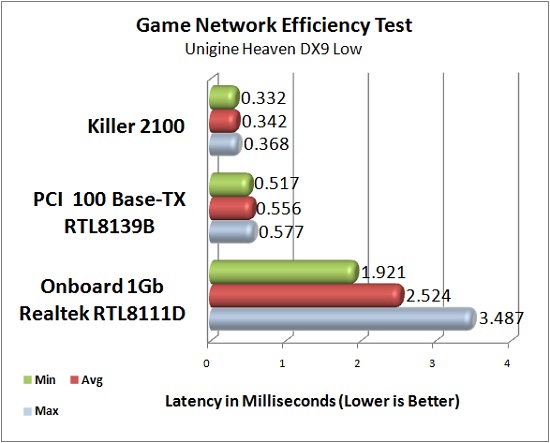
When the Host was running Unigine Heaven v2.1 at high shaders and 1x AF/0x AA at an average 77FPS, the Killer 2100 was incredibly consistent at ~.34ms, closely followed by the PCI card at ~.55ms. The onboard NIC was much slower; however, it was still only hitting a maximum of ~3.5ms which is not a difference you would notice in-game.
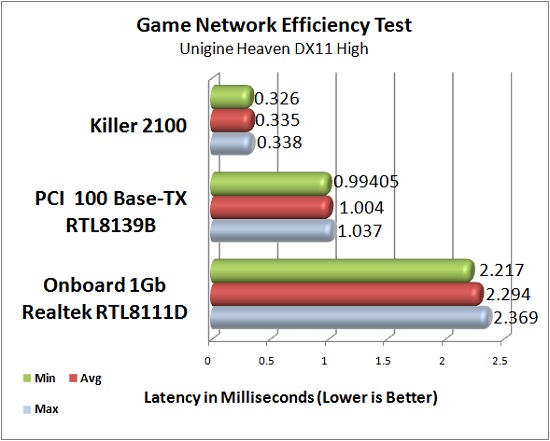
With the settings cranked up in Unigine to normal tessellation and 16x AF/8x AA at an average 34FPS, the PCI card falls behind the Killer 2100 slightly further to around 1ms; however, the onboard NIC was a little more consistent at 2.2ms. Again, this certainly would not be a difference in-game.
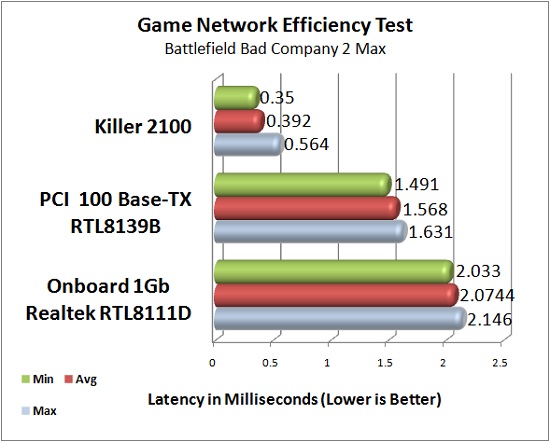
This time I ran Battlefield: Bad Company 2 at its highest possible settings with 16x AF/32x CSAA, and used the second scene of the single player campaign. Here the PCI card continued to fall behind the Killer 2100, with the onboard being again slightly faster than in the High Unigine testing.
As you can notice, the Killer 2100 was very consistent regardless of system load; however, the difference in actual latency is very small, so online gaming will likely not be affected due to the distance factor. Frequent LAN gaming, however, appears to be a very good reason to pick up the Killer 2100 because there are never fluctuations above .35ms which is spectacular.
Throughput Testing
The host and server PC were directly connected via one Cat 5e cable, removing the Ethernet switch as a bottleneck. File transfer was conducted via shared folder drag and drop, and the netperf application was used to test TCP and UDP throughput by sending ~1,460 byte (common game packet size) packets to the listen/server PC consistently over a period of time, 50 seconds. File transfer and TCP tests were run three times per NIC, and UDP testing was run four times per NIC.
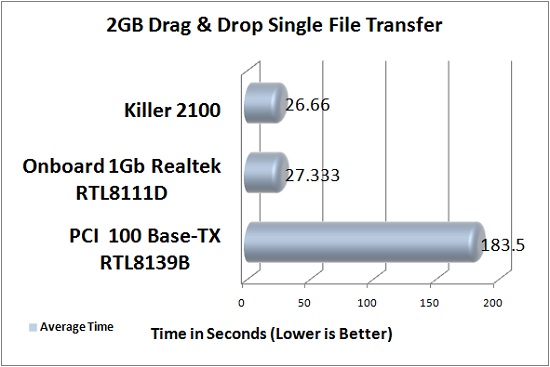
In file transfer testing, both the Killer 2100 and onboard Gigabit NICs could max out the read speeds of the old WD Raptor (~75MB/s, or ~600Mbit/s) with the 100Mbit PCI card taking significantly longer (10.8MB/s, or 87.2Mbit/s), which is obvious. The Killer 2100 did, however, consistently beat the onboard NIC by a small margin.
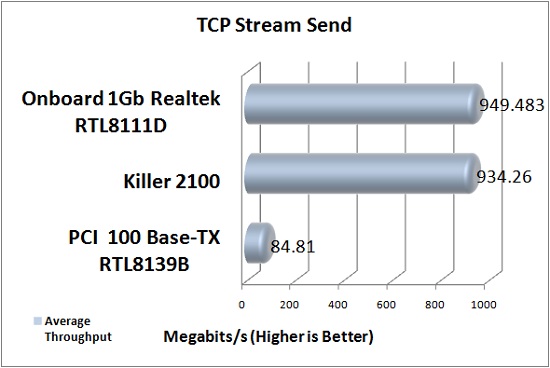
In TCP stream send testing, the Onboard NIC actually had slightly higher throughput than the Killer 2100 NIC.
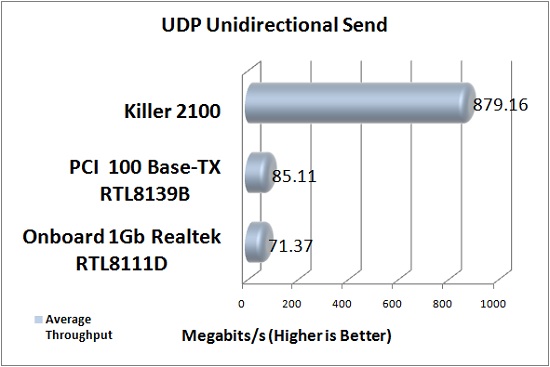
User Datagram Protocol is widely used in online games, and the Killer 2100 really excels here for throughput. However, online games are widely known to not use very much actual bandwidth and that Latency is the primary factor, so let’s continue on and check out how the Killer 2100 compares in actual gameplay.

Comments are closed.